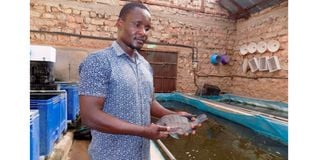Machakos farm supplies live fish to the market

Joseph Odhiambo explains how YY super male technology works at Kamuthanga Fish Farm in Machakos County.
At the slopes of Mua Hills in Machakos County is a well-known fish farm, Kamuthanga Fish Farm, the first fish farm in Africa to receive the EcoMark Africa label by the African Organisation for Standardisation (ARSO).
Anthony Ndeto established the farm a decade ago. He went through a number of challenges before FoodTechAfrica, a Dutch-based NGO, partnered with the fish farm.
Initially, the farm used an open field to rear fish but later adapted the recirculating aquaculture system (RAS) technology.
“It is a water reuse technology, so you don’t waste water. The dirty water that eventually comes from the cleaning of filters, is used to irrigate spinach, tomatoes and other vegetables,” explains Ndeto.
Joseph Odhiambo, the farm’s manager, who has worked here for almost eight years, says that traditionally in fish farming, one is allowed to stock four fish per square metre, but using RAS technology, one can rear 135 fish per square metre.
“The productivity is much higher in the same space and a little amount of water is used, so economic wise, water budget is very low, land space is reduced, and a very high production is achieved,” he says, adding that between 2014 to 2018, the farm was able to realise 30 times production capacity.
Read: Physics of fish farming
Currently, the farm can produce 100 tonnes of fish per year.
“With indoor fish farming, security is increased, and predation (birds) and biosecurity are also taken care of. When we introduced a greenhouse environment, production that took one year was achieved in less than five months and we were able to harvest reputable size fish ,” explains Odhiambo, who is a trained aquaculturist.
Indoor fish farming has given the farm control of production, control of quality and timely and sustainable supply to the market. They rear tilapia and catfish, which are warm-water fish. They adapt in the environment easily, and also their growth is much faster.
Kamuthanga Farm sources their breeds from the Netherlands. The breeds are improved and are called YY supermales, which are capable of growing two times faster than the female fish. The main challenge that they face is operation costs, such as the cost of the feeds and power.
Another challenge is the frozen fish coming from China, which sells “at a very low price”, says Odhiambo.
To stand out, the farm sells live fish in the market. They also plan to increase production and also to refine the system.
“The future plan is to see the production double by 2025. We have realised that you can produce double, not necessarily by increasing the space, rather, by increasing the size of the equipment that you have,” he explains.
The farm has 50 tanks, each with a capacity of 50,000 litres and production of 3,000kgs per production cycle.
According to Odhiambo, the biggest mistake most farmers make is stocking small fish in ponds. This reduces the survival rate, hence one can only get as low as 40-50 percent survival.
“For example, if you stock 1,000, you end up harvesting 400-500 pieces because they are young and can’t adapt. To avoid that, you need something like a nursery. A nursery can be a small cage within a big pond where you nurse them before you release them to the main pond.”
“When you stock that one, you get a survival rate as high as 90 or even 100 percent. We have the nursery for one reason – intensive care, secondly, to enhance survival. In the nursery there is warmth. Temperature is very key. Low temperature slows growth while high temperature speeds up the growth.”





